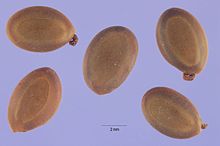Acacia confusa
| Acacia confusa | ||||||||||||
|---|---|---|---|---|---|---|---|---|---|---|---|---|

Acacia confusa |
||||||||||||
| Systematics | ||||||||||||
|
||||||||||||
| Scientific name | ||||||||||||
| Acacia confusa | ||||||||||||
| Merr. |
Acacia confusa is a species of Acacia within the legume family (Fabaceae). It is native to Southeast Asia , the Philippines , Taiwan and South China , is consideredan invasive plant in some tropical areas of the Pacific , particularly Hawaii, and is used, among other things, as a dye and medicinal plant.
description
Vegetative characteristics
Acacia confusa grows as an evergreen tree that can reach heights of 6 to 15 meters. The bark is smooth. The branches have a gray to brown bark and no thorns . The thin branches have an angular cross-section.
The straight or slightly sickle-like curved, leathery phyllodes are linear-lanceolate with a length of 6 to 10 centimeters and a width of usually 0.5 to 1.3 centimeters. Both the top and bottom of the leaf are bare. The base of the Phyllodium is pointed just like the upper end, whereby the upper end is slightly blunt and usually has a hook-like point.
Generative characteristics
Acacia confusa blooms in China from March to October. The spherical inflorescences are about 0.7 centimeters tall and are axillary in two to three tufts together or individually. The thin inflorescence stalks are 0.7 to 1.3 inches long.
The fragrant, golden yellow, hermaphrodite flowers are radial symmetry with a double flower envelope . The sepals are 1 to 1.3 millimeters long. The greenish petals are 1.5 to 1.9 millimeters in size. The numerous stamens are about 3.5 millimeters long. The single carpel is hairy and yellow-brown. The stylus is around 4 millimeters in size.
The flat black-brown legumes have a length of 4 to 12 centimeters and a width of 0.7 to 1 centimeter. The seeds are elliptical with a length of 5 to 6 millimeters and a thickness of 3.5 to 5 millimeters. The seeds ripen in China from August to December.
Chromosome number
The number of chromosomes is 2n = 26.
Occurrence
The natural range of Acacia confusa is in the Philippines . This species is cultivated in large parts of China and Taiwan . In Hawaii and on Hispaniola is Acacia confusa wild, is recognized as invasive plant .
Usage and ingredients
In addition to its minor importance as firewood , Acacia confusa is considered a dye and medicinal plant . The root bark contains up to 1.43% N -methyltryptamine (NMT) and 1.15% N , N -dimethyltryptamine (DMT) as well as tannins in concentrations of up to 35%. The strain also contains the alkaloids NMT and DMT, but in much lower concentrations of 0.04% and 0.01%, respectively. There have been reports of some psychoactive potential triggered by the presence of DMT. The seeds contain the toxic oxalyldiaminopropionic acid , which can cause spasticity and convulsive paralysis , up to and including death. The leaves contain three different compounds of the flavonoid myricetin .
Acacia confusa is used in traditional Chinese medicine for inflammation , fever , blood diseases and to strengthen the liver . Several studies show that both the bark and the heartwood have strong antioxidant properties due to their high phenol content . In another study, bark extracts containing the active ingredient gallic acid were able to improve the liver of rats with chronic liver problems or suppress the activity of the hepatitis C virus . In addition, it could be proven that plant extracts have a strong phytotoxicity , which suggests allelopathic properties of Acacia confusa .
Systematics
The first description of Acacia confusa was made in 1910 by Elmer Drew Merrill in Philippine Journal of Science , Volume 5, Number 1, pages 27-28. A synonym for Acacia confusa Merr. is Racosperma confusum (Merr.) Pedley .
Individual evidence
- ↑ a b c d e f Fabaceae (Legumnosae) . Acacia . In: Wu Zhengyi et al. (Ed.): Flora of China . Fabaceae . Volume 10. Science Press and Missouri Botanical Garden Press, Beijing, St. Louis 2010, pp. 56 (English, Acacia confusa - online ).
- ^ Acacia confusa in the Germplasm Resources Information Network (GRIN), USDA , ARS , National Genetic Resources Program. National Germplasm Resources Laboratory, Beltsville, Maryland. Retrieved August 19, 2015.
- ↑ Liu et al .: Study of the composition of the root bark of the Thoughtful Tree. In: Chinese Chemical Soc. , 1, 1977, pp. 15-16.
- ↑ Acacia confusa Merr. In: Andreas Kelich: Encyclopedia of Drugs . Retrieved December 28, 2013 .
- ↑ Quereshi et al .: Neurolathryogen, a-amino-B-oxalylaminopropionic acid (ODAP) in legume seeds. In: Phytochemistry , Volume 16, 1977, pp. 477-479.
- ↑ Lee et al .: Three New Flavonol Galloylglycosides from Leaves of Acacia confusa. In: Journal of Natural Products , Vol. 63, 5, 2000, pp. 710-712.
- ↑ a b Chang-Hung et al., 1998: Allelopathic Potential of Acacia confusa and Related Species in Taiwan. In: Journal of Chemical Ecology , 24 (12), 2131-2150.
- ↑ Chang et al., 2001: Antioxidant Activity of Extracts from Acacia confusa Bark and Heartwood. In: Journal of Agriculture and Food Chemistry , 49 (7), 3420-3424.
- ^ Tung et al .: Protective effect of Acacia confusa bark extract and its active compound gallic acid against carbon tetrachloride-induced chronic liver injury in rats. In: Food and Chemical Toxicology , Volume 47, 6, 2009, pp. 1385-1392.
- ↑ Jin-Ching Lee et al., 2011: Anti-hepatitis C virus activity of Acacia confusa extract via suppressing cyclooxygenase-2. In: Antiviral Research , Vol. 89, 1, pp. 35-42.
- ^ Acacia confusa at Tropicos.org. Missouri Botanical Garden, St. Louis, accessed August 19, 2015.

